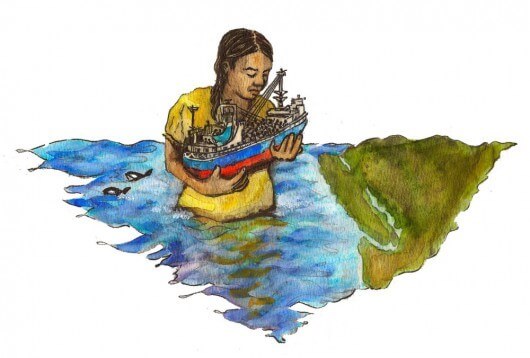
I want to tell you a story that I trust you know well. It’s a story that has been told world over by our people, but it seems no one is listening, not even ourselves. So, it’s a story that bears repeating:
The Story
There once were two distinct civilizations – unique in culture, language, religion, and genetic lineage – that lived on an island paradise. These two civilizations were themselves made up of different groups – villages, clans, families – that for various reasons would war with one another every now and then. Sometimes for territorial control, sometimes for vengeance, sometimes for reasons too complicated to fit into this sentence. Still, it was known that the island was home to all the different people.
Then one day some strange men showed up on a boat. They seemed very sick - they were pale even though they had spent considerable time at sea. Still, they insisted that everything was okay with them, and we all better get on with business. Unfortunately, their business depended on some shady accounting practices. Instead of accounting for how complex the differences were between the two civilizations, they insisted on treating the entire island as a singular asset, containing a singular people, posing a singular problem to be solved.
Over time (a century or two after the pale men first landed), in a series of struggles too complicated to fit into this paragraph, many people died, and the few who survived were told they all had to become one people to live. The survivors of the civilization that lost the war had to become a part of the civilization that won the war – and in doing so the culture of the loser civilization would be on a slow but sure path towards annihilation, it was hoped.
This is the story of how the Huron Nation was defeated, absorbed and dispersed by the Iroquois Confederacy in 1649, armed with the firepower of colonial interests. This tale is part of the untold history of Turtle Island (North America’s name in certain First Nations cultures), which was also home to many other civilizations once upon a time, some of which still hang on.
You may have interpreted this story as your own though. That’s okay, you wouldn’t be wrong. Like a disease, this narrative has indeed repeated itself in all the places the pale men once grabbed and left ravaged. It’s natural to project your own experiences into the characters you read. Still, if you live on Turtle Island at present and the reading of this story did not trigger an acknowledgement of parallel histories with First Nations, there is a problem, no?
A Truth to Reconcile
Over the last few decades, the Tamil diaspora from Ceylon has tried ceaselessly to tell this story as it relates to our people in the hopes of securing help. There has been frustration and resentment about the blind eyes we receive in turn. Yet if we ourselves are not listening to this story when told by others, recognizing the urgency of the cries and responding accordingly - why should we expect to be heard?
True, it is our duty to advocate for the protection and betterment of our own people – no one else will lead this charge. But doing so is not mutually exclusive to standing in solidarity with other oppressed communities; rather, this is strategically superior to standing alone. Idle No More, Palestinian activists, Black Lives Matter and recently Standing Rock Sioux tribe have done this to great effect. Joining hands and actively showing up magnifies the voice and multiplies the momentum of all movements involved.
Let’s also not forget that when the most recent boats of Tamil refugees came to Canadian shores, it was the Esquimalt First Nation that held spiritual prayers welcoming us into their traditional territories – despite the modern-day incarnation of the pale men demanding “Tigers: don’t unpack, you’re going back.”1

Specifically, with respect to First Nations and Native American activism, our own people’s future lies in the hands of their victories – they are fighting for the sanctity of water and life on this planet, not just their own, by opposing pipelines that unlawfully cross their land. These pipelines increase the extraction and burning of fossil fuels to a point where catastrophic climate change will be inevitable and irreversible. Mind you that this extraction is primarily for foreign markets (Kinder Morgan, Line 9), so please don’t confuse this development with increasing Canada’s energy security or reducing the price at the pump.
The consequences of flying past the climate tipping point are unprecedented global food insecurity from increased desertification, droughts and extreme weather, mass and chronic global famine, increased range and virality of fatal disease, loss of coastal lands to rising sea levels, endless waves of internal and external displacement, and an escalation of violence, war, and ideological radicalization stemming from all this.
Sound familiar? That’s because we’re living it. Still sitting atop the tip of the melting iceberg, mind you.
Beyond the immediate impact of these trajectories on our own lives and that of our children (the rise of fascist white supremacy in North America and Europe), this represents the definitive end of Eelam. Some projections estimate that being a relatively low-lying region, Jaffna will be underwater by the end of this century (in some of your lifetimes)2. The dark implications of this are amplified by the fact that refugees will likely face draconian and oft-deadly measures against them at that time. A recent Oxford University study projects 200 million environmental refugees by 2050 alone; if Europe feels flooded by 1 million refugees in 2015, what will their solution be for refugees in 2100?3
In Canada, due to the Treaty rights that many First Nations hold - rights allegedly protected by Canada’s Constitution - their resistance efforts have had the greatest impact in curbing climate change. Their successful legal challenge against Enbridge’s Northern Gateway pipeline – based on the Feds failure to consult – contributed greatly to the government not granting an approval of the project.4
Crimes Against Humanity
All this said, the greatest reason why the Tamil diaspora living on Turtle Island should actively support First Nations is because it is the right thing to do. As humans, First Nations have a right to clean water, to their food sources, to their land, and have a right to protect and continue their existence without further pillaging and displacement by pale men cultures.
There are countless frontiers on Turtle Island where First Nations and Native Americans are fighting for their rights and basic human dignities. Within the borders of Canada, some contexts that come to mind include: the Lubicon Cree of Little Buffalo5, the Heiltsuk of Bella Bella6, the Grassy Narrows and Wabaseemoong First Nations7, and the Treaty 8 First Nations of the Peace River Valley8, to name but a very few.
All the aforementioned have had their access to food and water jeopardized. Some, like the Lubicon Cree, live with one of the highest rates of miscarriages and stillbirths in the country due to the unlawful oil extraction that happens on their land.9 Others like the residents of Grassy Narrows live with over 90% of their population showing symptoms of mercury poisoning; even though the initial dumping of industrial waste into their river systems happened over 50 years ago, there has been no action by provincial or federal governments to clean the contamination.10
Understand that most First Nations communities still depend on hunting, trapping and fishing to sustain themselves. This is not a lifestyle they can walk away from. They cannot simply relocate their communities into the cities and suburbs without forsaking who they are and what they believe. Living in symbiosis with the life on their land is sacred to them. This way of being is as integral to their spirituality as not eating meat on a day we go to temple is to ours. Many Tamils have forgotten the teachings behind our own customs; First Nations have not.
Unfortunately, this way of existing is fundamentally at odds with the pale men system that has now colonized the globe. Over the coarse of the last five centuries, the pale men have spread propaganda globally – not too different in tone or form as the Sri Lankan government’s propaganda against Tamils – to ensure that both domestic and foreign onlookers disregard the oppression and silencing of First Nations. As with Tamil survivors of the Sri Lankan genocide, the continued existence of First Nations – as a people and as a culture – is itself an act of rebellion. Which side of that struggle will Tamils living on Turtle Island be on?
Your true stripes
At this point, I trust you’re asking, “so what can I do?” The answer is quite simple – pay attention. Turtle Island is the homeland of First Nations, their stories are all around you. Train yourself to recognize, understand, and retell these stories. Understanding why First Nations resist is the first step to aiding their fight.
While you build this understanding, seek out opportunities where we as Tamils can show up to First Nations actions. Better yet, create opportunities where we can invite and include First Nations communities at our own events and build a deep brotherhood between our people.
Tamils in Canada have proven themselves to be an indispensable voting block - a political force - largely due to the concentration of our population in the GTA. In two consecutive federal elections, we have elected Tamils to Parliament. We are known to show up to the vote, and when needed the streets and highways in mass numbers. We have power. Let’s extend this power to other groups and in doing so multiply the reach of all our stories.
---------
As an immediate action consider supporting the Chippewas of the Thames Supreme Court Challenge against the Line 9 pipeline by donating towards their legal fund, informing yourself on their story and spreading the word:
https://www.gofundme.com/chippewas
http://cottfn.com/duty-to-consult/
Sources:
[1] Sivalingam, H. (2013, September). Refugee Review: Social Format. Retrieved from https://refugeereview.wordpress.com/practitioner-reports/sivalingam-harini/#_ftn4
[2] Gunawardene, N. ( 2013, April 7). When Worlds Collide #61: Climate Change – Adapt Now or Perish Later!. Retrieved from https://collidecolumn.wordpress.com/2013/04/07/when-worlds-collide-61-climate-change-adapt-now-or-perish-later/
[3] Dinshaw, F. (2015, October 30). Exodus. Retrieved from http://www.nationalobserver.com/2015/10/30/exodus-climate-refugees-has-just-begun-where-will-they-go
[4] Tasker, J. P. (2016, September 20). Ottawa won't appeal court decision blocking Northern Gateway pipeline. Retrieved from http://www.cbc.ca/news/politics/enbridge-northern-gateway-federal-court-1.3770543
[5] Amnesty International. The Lubicon Cree: Ongoing human rights violations. Retrieved from http://www.amnesty.ca/our-work/issues/indigenous-peoples/the-lubicon-cree-ongoing-human-rights-violations
[6] National Observer. (2016, October 19). Heiltsuk First Nation reacts to diesel spill. Retrieved from https://www.youtube.com/watch?v=AwA57KOYVC4&feature=share
[7] Porter, J. (2016, December 21). 'Overt environmental injustice' continues at Grassy Narrows, medical journal concludes. Retrieved from http://www.cbc.ca/news/canada/thunder-bay/medical-journal-grassy-narrows-1.3906039
[8] Amnesty International. Site C Dam – Human Rights at Risk. Retrieved from http://www.amnesty.ca/our-work/issues/indigenous-peoples/indigenous-peoples-canada/resource-development-canada/site-c-dam
[9] Amnesty International. Canada: 20 years denial of recommendations made by the United Nations Human Rights Committee and the continuing impact on the Lubicon Cree. Retrieved from https://www.amnesty.ca/sites/amnesty/files/2010-03-17amr200032010en20yearsdeniallubicon.pdf
[10] Leslie, K. (2016, September 20). 90% of Grassy Narrows residents show mercury poisoning signs: researchers. Retrieved from http://www.theglobeandmail.com/news/national/90-of-grassy-narrows-residents-show-mercury-poisoning-signs-researchers/article31966087/

























